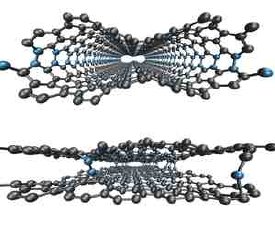Nanoscale simulations and theoretical research performed at the Department of Energy's Oak Ridge National Laboratory are bringing scientists closer to realizing graphene's potential in electronic applications.
A research team led by ORNL's Bobby Sumpter, Vincent Meunier and Eduardo Cruz-Silva has discovered how loops develop in graphene, an electrically conductive high-strength low-weight material that resembles an atomic-scale honeycomb.
 ORNL simulations demonstrate how loops (seen above in blue) between graphene layers can be minimized using electron irradiation (bottom).
ORNL simulations demonstrate how loops (seen above in blue) between graphene layers can be minimized using electron irradiation (bottom).
Structural loops that sometimes form during a graphene cleaning process can render the material unsuitable for electronic applications. Overcoming these types of problems is of great interest to the electronics industry.
"Graphene is a rising star in the materials world, given its potential for use in precise electronic components like transistors or other semiconductors," said Bobby Sumpter, a staff scientist at ORNL.
The team used quantum molecular dynamics to simulate an experimental graphene cleaning process, as discussed in a paper published in Physical Review Letters. Calculations performed on ORNL supercomputers pointed the researchers to an overlooked intermediate step during processing.
Imaging with a transmission electron microscope, or TEM, subjected the graphene to electron irradiation, which ultimately prevented loop formation. The ORNL simulations showed that by injecting electrons to collect an image, the electrons were simultaneously changing the material's structure.
"Taking a picture with a TEM is not merely taking a picture," Sumpter said. "You might modify the picture at the same time that you're looking at it."
The research builds on findings discussed in a 2009 Science paper (Jia et al.), where Meunier and Sumpter helped demonstrate a process that cleans graphene edges by running a current through the material in a process known as Joule heating. Graphene is only as good as the uniformity or cleanliness of its edges, which determine how effectively the material can transmit electrons. Meunier said the ability to efficiently clean graphene edges is crucial to using the material in electronics.
"Imagine you have a fancy sports car, but then you realize it has square wheels. What good is it? That's like having jagged edges on graphene," Meunier said.
Recent experimental studies have shown that the Joule heating process can lead to undesirable loops that connect different graphene layers. The PRL paper provides an atomistic understanding of how electron irradiation from a transmission electron microscope affects the graphene cleaning process by preventing loop formation.
"We can clean the edges, and not only that, we're able to understand why we can clean them," Meunier said.
The research team included scientists from Massachusetts Institute of Technology, Universite Catholique de Louvain and Carlos III University of Madrid. Sumpter and Meunier are members of ORNL's Computer Science and Mathematics division with appointments in the Nanomaterials Theory Institute within the Center for Nanophase Materials Sciences. Cruz-Silva is a post-doctoral researcher at ORNL.